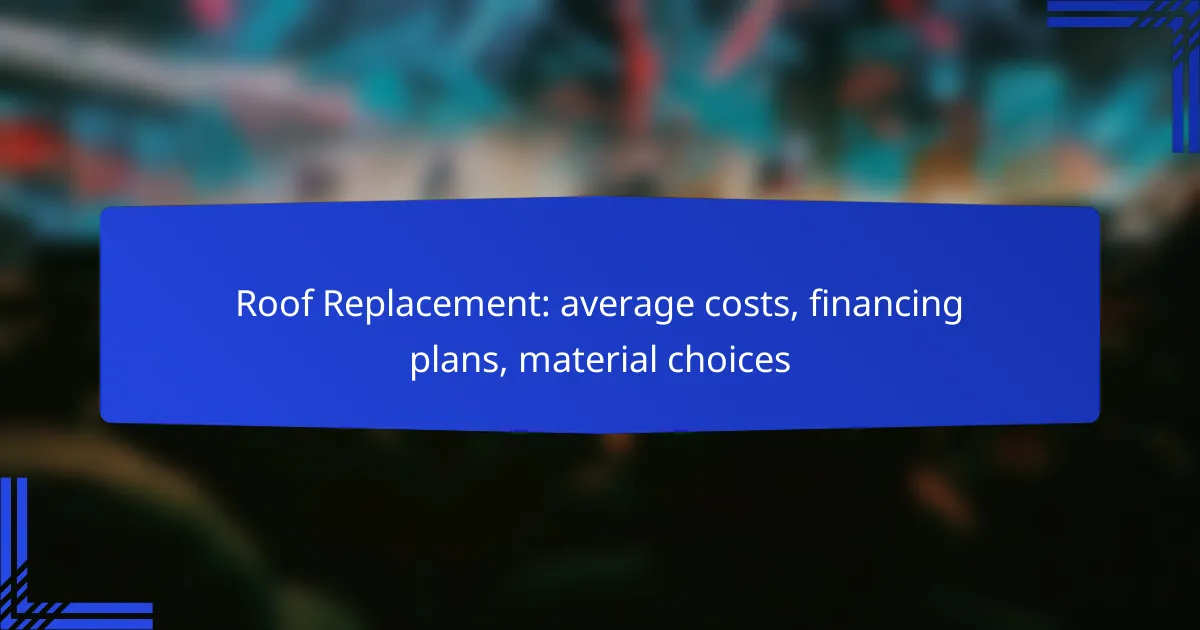Replacing a roof is a significant investment for homeowners, with average costs in the UK ranging from £5,000 to £10,000 based on materials and job complexity. To ease the financial burden, various financing plans such as home equity loans and personal loans are available, each with distinct advantages. Additionally, selecting the right roofing material—whether asphalt shingles, slate, or metal—can impact both durability and aesthetic appeal, making careful consideration essential.
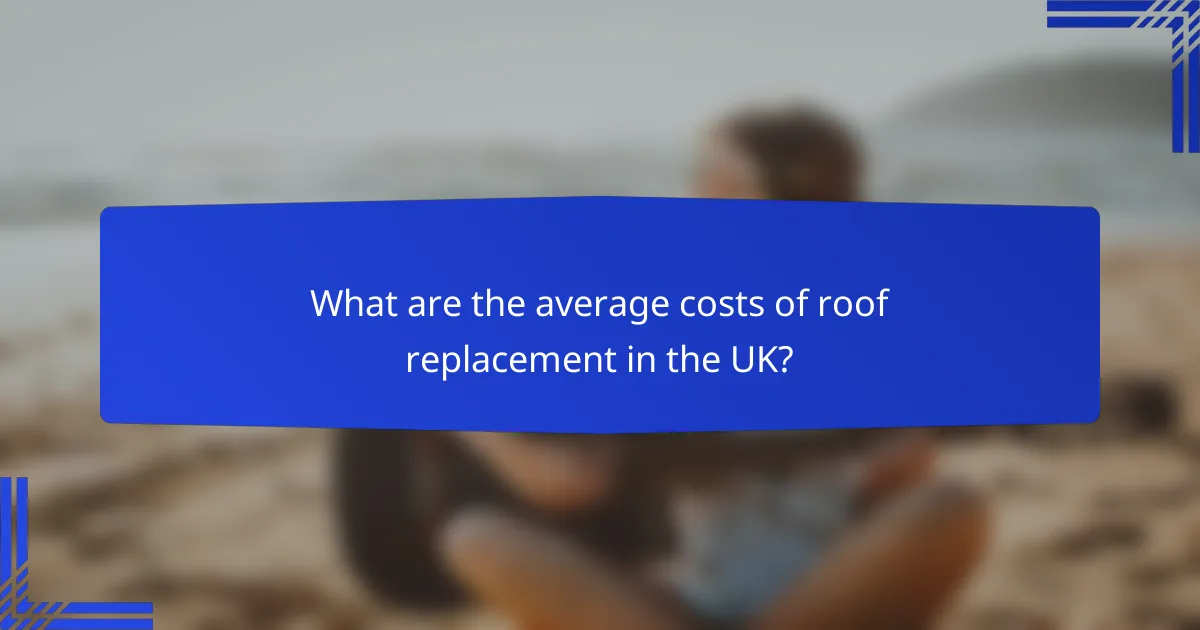
What are the average costs of roof replacement in the UK?
The average costs for roof replacement in the UK typically range from £5,000 to £10,000, depending on the materials used and the complexity of the job. Homeowners should consider both the upfront costs and potential financing options available to manage expenses effectively.
Cost range for asphalt shingles
Asphalt shingles are among the most popular roofing materials due to their affordability and ease of installation. The cost for replacing a roof with asphalt shingles generally falls between £3,000 and £6,000 for an average-sized home.
Factors such as the quality of shingles and the complexity of the roof design can influence the final price. Homeowners should also consider the lifespan of asphalt shingles, which typically lasts around 20 to 30 years.
Cost range for slate roofs
Slate roofs are known for their durability and aesthetic appeal, but they come at a higher price point. The cost for slate roof replacement usually ranges from £10,000 to £20,000, depending on the size and type of slate used.
While slate roofs can last over 100 years, the initial investment is significant. It’s essential to hire experienced contractors familiar with slate installation to ensure quality workmanship.
Cost range for metal roofs
Metal roofs, including options like steel and aluminum, offer longevity and energy efficiency. The cost for replacing a roof with metal materials typically ranges from £6,000 to £12,000.
Metal roofs can last 40 to 70 years and are often more resistant to extreme weather conditions. However, the installation process can be more complex, which may increase labor costs.
Factors affecting roof replacement costs
Additional costs may arise from necessary repairs to the underlying structure, local labor rates, and any required permits. Homeowners should obtain multiple quotes from contractors to ensure they receive a fair price for their project.

What financing plans are available for roof replacement?
Several financing plans can help homeowners manage the costs of roof replacement, including home equity loans, personal loans, and government grants. Each option has its own benefits and considerations, making it essential to evaluate which plan aligns best with your financial situation.
Home equity loans
Home equity loans allow homeowners to borrow against the equity they have built in their property. Typically, these loans offer lower interest rates compared to personal loans because they are secured by the home. Borrowers can usually access amounts ranging from tens of thousands to over a hundred thousand dollars, depending on their equity and lender policies.
When considering a home equity loan, it’s crucial to assess your ability to repay the loan, as failure to do so could result in losing your home. Additionally, be aware of closing costs and fees that may apply, which can add to the overall expense of the loan.
Personal loans
Personal loans are unsecured loans that can be used for various purposes, including roof replacement. These loans typically have higher interest rates than home equity loans, but they do not require collateral, making them accessible to a broader range of borrowers. Loan amounts can vary widely, often from a few thousand to tens of thousands of dollars.
When opting for a personal loan, shop around for the best interest rates and terms. Consider your credit score, as it significantly impacts the rates you will be offered. Be cautious of any hidden fees or prepayment penalties that could affect the total cost of the loan.
Government grants and assistance
Government grants and assistance programs can provide financial help for roof replacement, especially for low-income households or those in specific regions. These programs often do not require repayment, making them an attractive option for eligible homeowners. Availability varies by location, so it’s essential to research local and state programs.
To access these funds, homeowners typically need to demonstrate financial need and may have to meet specific criteria. Check with local housing authorities or community organizations for information on available grants and the application process. Be prepared to provide documentation of income and homeownership status to qualify for assistance.
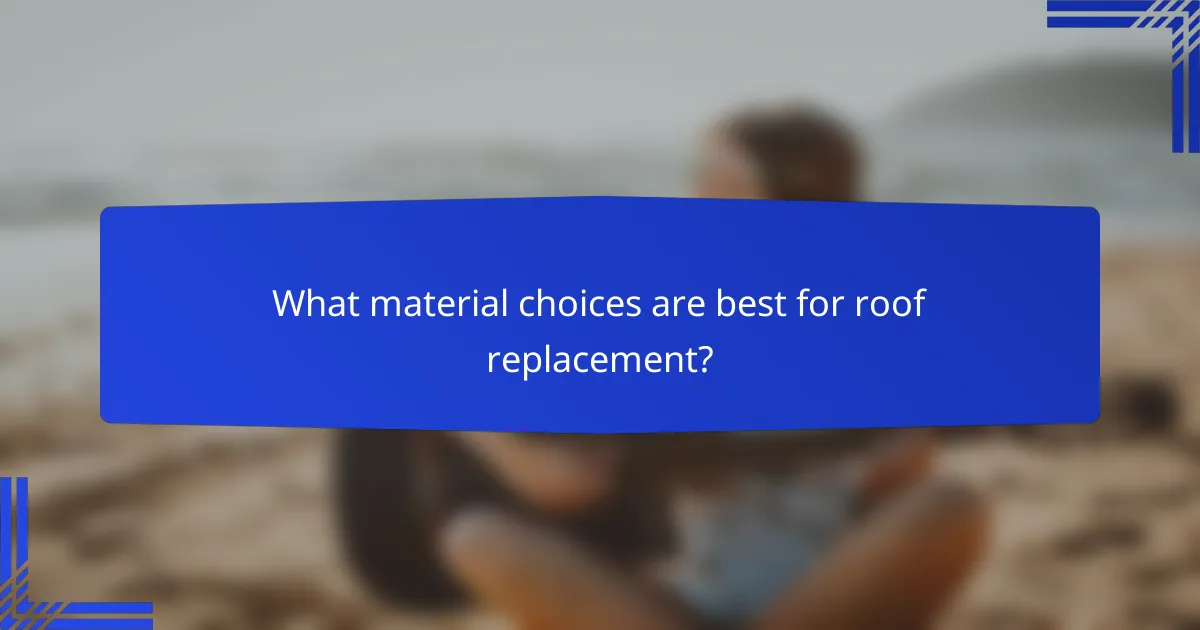
What material choices are best for roof replacement?
When replacing a roof, the best material choices depend on factors like durability, cost, and aesthetic appeal. Common options include asphalt shingles, slate, and metal roofing, each offering unique benefits and considerations.
Benefits of asphalt shingles
Asphalt shingles are one of the most popular roofing materials due to their affordability and ease of installation. They typically cost between $90 and $100 per square (100 square feet) and can last around 20 to 30 years with proper maintenance.
These shingles come in a variety of colors and styles, allowing homeowners to achieve the desired look for their property. Additionally, they are lightweight, making them suitable for most residential structures without requiring additional support.
Advantages of slate roofing
Slate roofing is known for its exceptional durability and longevity, often lasting over 100 years. While the initial cost can be significantly higher, ranging from $600 to $1,500 per square, the investment can pay off in the long run due to minimal maintenance needs.
Slate is also fire-resistant and can withstand harsh weather conditions, making it ideal for areas prone to extreme climates. Its natural beauty adds a unique aesthetic value that can enhance property appeal and resale value.
Pros and cons of metal roofing
Metal roofing is gaining popularity for its durability and energy efficiency. It typically costs between $300 and $700 per square and can last 40 to 70 years. Metal roofs reflect solar heat, which can lower cooling costs in warmer climates.
However, they can be prone to denting from hail and may require additional insulation to minimize noise during rain. It’s essential to weigh these factors against the benefits when considering metal roofing for your home.
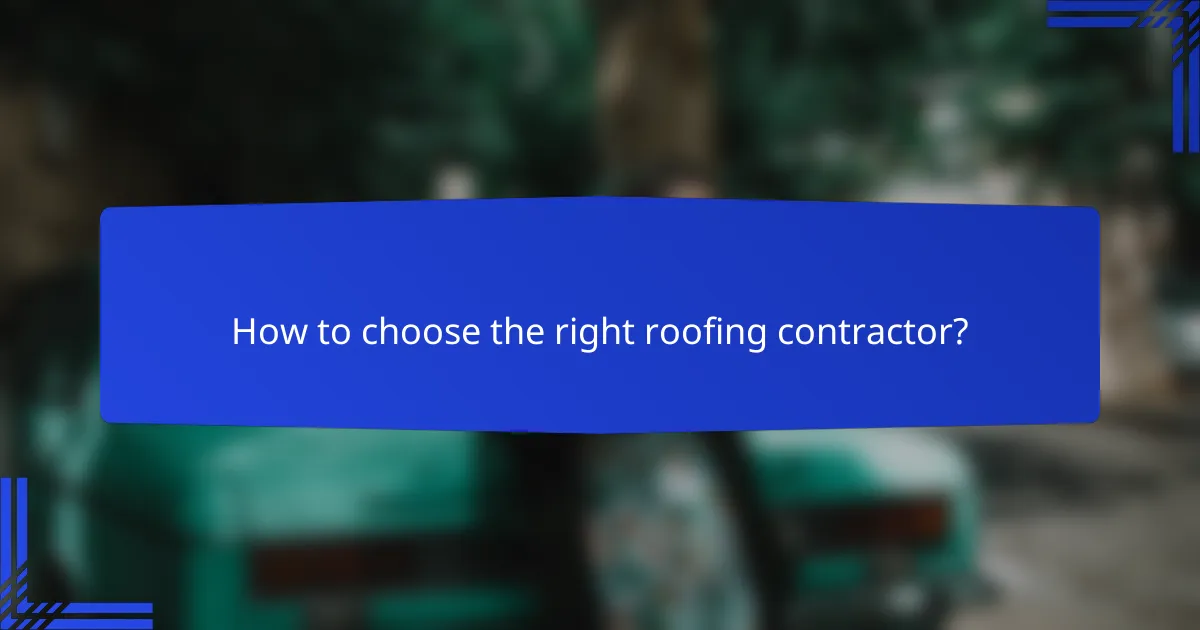
How to choose the right roofing contractor?
Choosing the right roofing contractor is crucial for ensuring quality work and a successful project. Look for licensed, insured professionals with a solid reputation and experience in your specific roofing needs.
Key questions to ask potential contractors
When interviewing roofing contractors, ask about their licensing and insurance status to ensure they comply with local regulations. Inquire about their experience with your preferred roofing materials and request a detailed estimate that includes labor, materials, and timelines.
Additionally, ask about warranties on both materials and workmanship. A reliable contractor should offer a warranty that protects your investment for several years.
Importance of checking references
Checking references is essential in verifying a contractor’s reliability and quality of work. Request a list of past clients and reach out to them to ask about their experiences, including project timelines and satisfaction levels.
Look for online reviews and ratings on platforms like Google or Yelp, as these can provide insights into the contractor’s reputation. A contractor with consistently positive feedback is more likely to deliver satisfactory results.
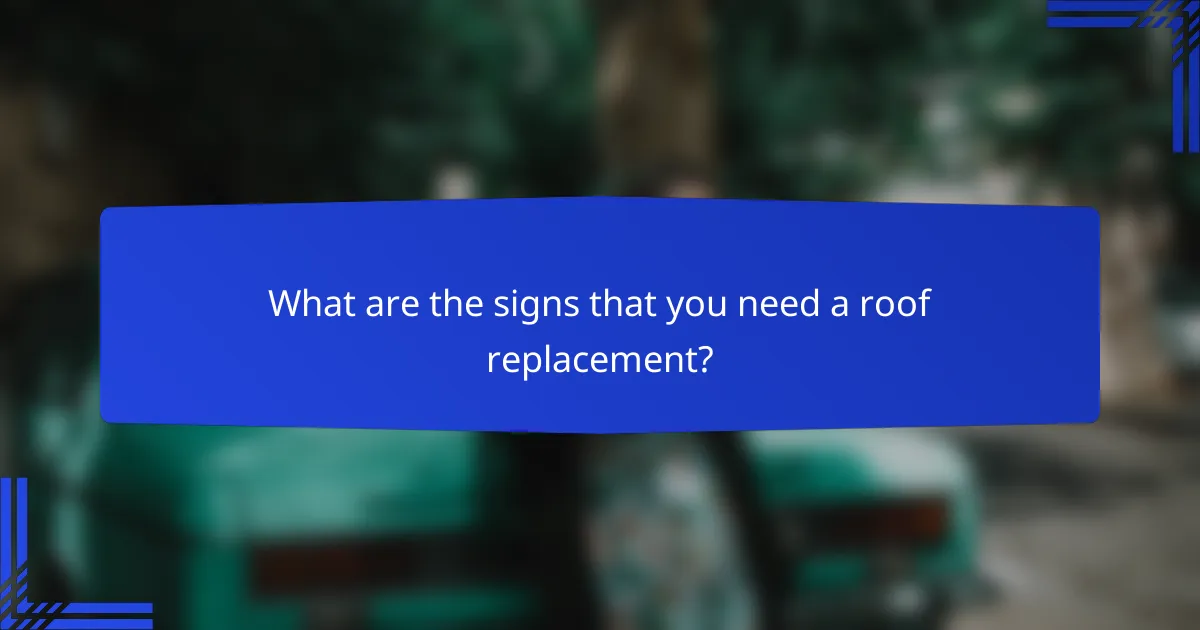
What are the signs that you need a roof replacement?
Signs that indicate a roof replacement is necessary include visible leaks, significant water damage, and the age of the roof. Recognizing these indicators early can help prevent further damage and costly repairs.
Visible leaks and water damage
Visible leaks and water damage are clear signs that your roof may need replacement. If you notice water stains on ceilings or walls, it often indicates that water is penetrating through the roof. Regular inspections can help identify these issues before they escalate.
Look for discoloration or peeling paint, especially in areas directly under the roof. If leaks are frequent, it may be more cost-effective to replace the roof rather than continually repairing it.
Age of the roof
The age of your roof is a critical factor in determining whether it needs replacement. Most roofs have a lifespan of 20 to 30 years, depending on the materials used. If your roof is approaching or has exceeded this age, it’s wise to consider a replacement.
Even if there are no visible issues, older roofs may not perform well against severe weather conditions. Regular assessments can help you gauge whether your roof is still reliable or if it’s time for an upgrade.
Missing or damaged shingles
Missing or damaged shingles are strong indicators that your roof may require replacement. Shingles can become loose or break due to weather conditions, age, or poor installation. If you notice several missing or cracked shingles, it may compromise the roof’s integrity.
Inspect your roof regularly for signs of shingle damage, such as curling, buckling, or granule loss. If the damage is extensive, replacing the entire roof may be more beneficial than patching up individual areas.
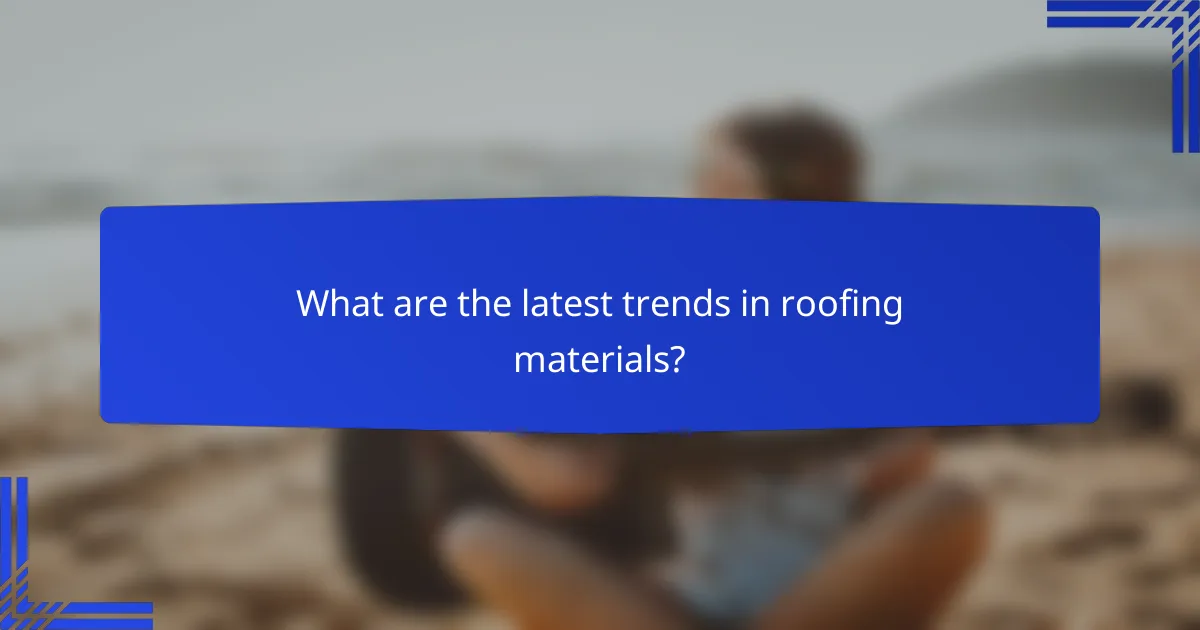
What are the latest trends in roofing materials?
Recent trends in roofing materials focus on sustainability, energy efficiency, and durability. Homeowners are increasingly opting for eco-friendly options like metal and solar roofs, which offer long-term savings and environmental benefits.
Eco-friendly materials
Eco-friendly roofing materials, such as recycled shingles and green roofs, are gaining popularity due to their minimal environmental impact. These options not only reduce waste but also improve energy efficiency by providing better insulation.
For instance, metal roofs made from recycled materials can last over 50 years, significantly reducing the need for replacements. Additionally, green roofs, which incorporate vegetation, can help manage stormwater and improve air quality.
Energy-efficient options
Energy-efficient roofing materials, like cool roofs and solar shingles, are designed to reflect more sunlight and absorb less heat. This can lead to lower energy bills and a more comfortable indoor environment.
Cool roofs, often made from reflective coatings or materials, can reduce roof temperatures by up to 30%. Solar shingles not only serve as a roof but also generate electricity, making them a dual-purpose investment.
Durable materials
Durability is a key consideration in roofing trends, with materials like slate, tile, and metal being favored for their longevity. These materials can withstand harsh weather conditions, reducing the frequency of repairs and replacements.
For example, slate roofs can last over 100 years, while metal roofs can endure extreme temperatures and resist rust. Choosing durable materials can lead to significant long-term savings in maintenance costs.
